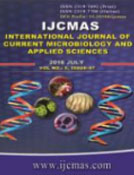


 National Academy of Agricultural Sciences (NAAS)
National Academy of Agricultural Sciences (NAAS)

|
PRINT ISSN : 2319-7692
Online ISSN : 2319-7706 Issues : 12 per year Publisher : Excellent Publishers Email : editorijcmas@gmail.com / submit@ijcmas.com Editor-in-chief: Dr.M.Prakash Index Copernicus ICV 2018: 95.39 NAAS RATING 2020: 5.38 |
Ear infections can occur in all age groups. Otitis media is one of the most common illness in ENT practice and occurring all over the world. It may even cause hearing impairment especially neural deafness if it is not treated beneath expert care. The study was done to know the spectrum of different pathogens and its antimicrobial sensitivity causing ear infections among all age groups. A total of 295 ear samples were collected and processed according to standard microbiological procedures. Gram negative bacteria were isolated more frequently as correspond to gram positive (47.24 and 43.72% respectively). The frequency of gram positive bacterial isolates was Staphylococcus aureus (37.2%), Streptococcus pyogenes (3.0%), Streptococcus pneumoniae (2.5%) and Enterococcus spp. whereas the frequency of gram negative bacterial isolates was Pseudomonas aeruginosa (34.2%) followed by Escherichia coli (4.0%), Proteus mirabilis (4.0%), Klebsiella pneumoniae (2.5%) and Enterobacter aerogenes (2.0%). The most frequent fungal isolates were Aspergillus spp. (5.0%) followed by Candida spp. (4.0%). Continuous knowledge of the pathogens responsible for ear infections and choice of suitable antibiotics according to sensitivity test results will guide the clinician for the treatment thus reducing the complication of ear infections and curbing resistant to antibiotics.
 |
 |
 |
 |
 |